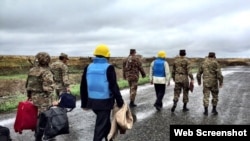The chief U.S. negotiator in the Nagorno-Karabakh peace process has met with several members of the U.S. Congress to discuss specific measures against increased ceasefire violations in the Armenian-Azerbaijani conflict zone that are strongly advocated by them.
James Warlick, the U.S. co-chair of the OSCE Minsk Group, said he discussed “Nagorno-Karabakh peace” with Ed Royce, the chairman of the House Foreign Affairs Committee, and other members of the panel on Wednesday.
“We agreed to work for a settlement,” Warlick wrote on his Twitter page. He did not give details.
A statement by the House Foreign Affairs Committee quoted Royce as saying after the meeting: “Violence in the Nagorno-Karabakh region is at the highest point in decades. Just last month we heard reports of heavy weapon attacks and tank artillery fire – a clear violation of the ceasefire agreement.”
“As Ambassador Warlick has said, this isn’t a ‘frozen conflict,’ but is a forgotten conflict – with a real risk of spinning out of control,” he added.
Royce announced the upcoming meeting with the American mediator last month when he addressed a Capitol Hill event dedicated to the 24th anniversary of Karabakh’s declaration of independence from Azerbaijan. The pro-Armenian lawmaker renewed his calls for the U.S., Russian and French mediators to press Azerbaijan to accept major safeguards against intensifying violence in the Karabakh conflict zone.
Royce initiated in late October a joint letter by over 80 U.S. legislators to Warlick listing three measures which they believe would minimize deadly fighting there. Those include withdrawal of snipers by both warring sides, deployment of more OSCE observers, and installation of gunfire-locator systems on the Karabakh frontline. Warlick reportedly backed the proposed safeguards on behalf of the U.S. State Department.
“The faster the [U.S.] administration can help put these in place, the quicker it can help put an end to the killing and avert war,” Royce said after the meeting with Warlick.
“Why haven’t those in the Minsk Group moved forward to endorse this?” the congressman asked during the December 9 celebration on Capitol Hill. He said he and other members of the U.S. House of Representatives will discuss the matter with Warlick.
Incidentally, Warlick was present at the annual event co-hosted by the U.S. Congressional Caucus on Armenian Issues and the two main Armenian-American lobby groups, prompting a strong condemnation by Baku.
The Minsk Group co-chairs have long been urging the conflicting parties to withdraw their snipers and agree to a mechanism for international investigations of armed incidents. These measures are backed by Armenia and the Karabakh Armenians but rejected by Azerbaijan. Azerbaijani Foreign Minister Elmar Mammadyarov reiterated in November that they would only reinforce the status quo favoring the Armenian side.
Throughout 2015 fighting around Karabakh and the Armenian-Azerbaijani border increasingly involved mortars and other heavy weapons. Both parties suffered the largest number of combat casualties since a Russian-brokered truce stopped the Armenian-Azerbaijan war in 1994.
The most recent upsurge in truce violations came on eve of a December 19 meeting of the Armenian and Azerbaijani presidents held in Switzerland. Although the two leaders reportedly made no progress towards resolving or deescalating the conflict, neither side has reported deadly incidents for the past two weeks.
In a New Year address to the Azerbaijani military, Azerbaijan’s Defense Minister Zakir Hasanov expressed hope that 2016 “will go down in history as a year of Karabakh’s liberation from the occupiers.” “The Karabakh land will burn under the occupiers’ feet,” Hasanov said.





